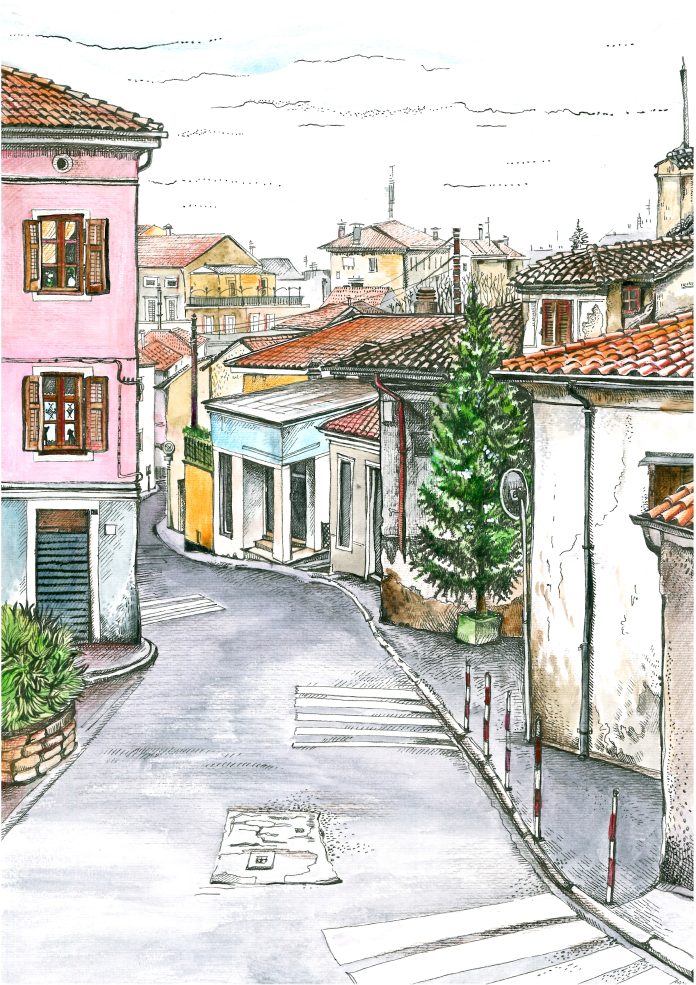by Victor Caneva
Shooting skyward atop the steep hill above the Servola tunnel, the steeple of the Church of St. Lawrence the Martyr always caught my eye. “What is that steeple doing in the middle of this industrial area by the sea – there has to be a story here,” I would think as I drove southbound from Trieste. Then I’d forget about it as I motored away.
After living in Trieste for four years, I’ve experienced most of the city’s rioni (neighborhoods) on foot. I love to discover a place slowly – walking, listening, smelling, tasting, and experiencing the substance that makes each rione unique. Servola, originally a village on the southern outskirts of Trieste, had eluded me.
Thanks to an auto appointment and the need for a walk, I decided to take the long way home on foot and finally discover Servola. I expected a gritty area near the old ironworks, demolished in September of last year, lying where the neighborhood bumps into the sea.
Walking northward from Valmaura and topping San Pantaleone hill, an unexpectedly verdant urban oasis, a novel perspective revealed that Servola wasn’t just a random church in an industrial zone but an ancient village incorporated into modern Trieste. In fact, Servola, which derives its name from the Latin Sylvula, meaning “small forest,” was first mentioned in 1256. The hamlet expanded in 1303, when Bishop Pedrazzani brought settlers from his hometown of Soncino in the province of Cremona to help build San Giusto Cathedral. Today, Via dei Soncini cuts through the neighborhood, and Sancin (or Sanzin) is one of the most common surnames in Servola.
As I meandered through the neighborhood, I felt like I had been zapped to another place and time. Knowing that I was a stone’s throw from some of the biggest arteries negotiating Trieste, I was not expecting the quiet, small-town ambiance I experienced. Narrow lanes cut through centuries-old homes, and Habsburg era palaces hung over the greenery bordering Via di Servola.
And I kept noticing references to bread. White bread. I pondered these references while spotting a bakery on Via di Pane Bianco (or “White Bread Way”). What was this all about? A little research revealed that in the mid-1700s, Servola’s “Bighe Servolane” were all the rage in Austria-Hungary. The Bighe, small buns of white bread crafted out of dough balls joined in pairs, were considered the finest bread in the empire. Pancogole, or bread porters, from tiny Servola were twice invited to Vienna to impart their expertise to the bakers in Austria’s capital. For some reason or another, the Austrian bakers were unable to recreate the renowned buns, but their fame had been firmly established.
Everything changed as I descended Servola’s hill and followed Via Baiamonti to buzzing Via Svevo. The village I had been in just five minutes earlier felt like a curious impossibility as I crossed four lanes of traffic and watched commuters hurry their way somewhere. I hurried on my way as well. Life had regained its usual brisk pace, but I was thankful for my unexpected hiatus in surprising Servola.
In conclusion, Servola is more than just an industrial backdrop; it is a living testament to Trieste’s rich history. From its ancient roots to the prominence of the “Bighe Servolane,” this hidden gem has much to offer those willing to explore beyond the beaten path. The juxtaposition of historical charm and modern hustle along the winding streets of Servola paints a vivid picture of a village that time almost forgot.





























